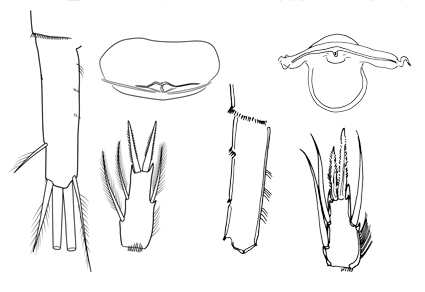Abstract
Representatives of freshwater cyclopid Archaeodiacyclops okhensis gen. nov., sp. nov. were found in river ecosystems of northern Sakhalin Island (East Russia). General structure of these specimens corresponds to genus Diacyclops. An unusual feature of these specimens is the retained hairs on the inner side of the caudal branches, which are usually absent in the genus Diacyclops. Analysis of the world fauna of the genus Diacyclops made it possible to describe a new genus and include the newly described species there, along with five already known species. The main diagnostic features for the new genus, in addition to the structure of the fifth pair characteristic of Diacyclops, are the combination of the unreduced structure of antennules (17-segmented), swimming legs (3-segmented) and caudal rami with presence of hair-setules on the inner side. The new genus includes 5 species, distributed mainly in the water bodies of the Americas. The finding of the newly described species outside this region is an additional evidence of some similarity of American and East Asian freshwater faunas. The article provides an identification key for species of a new genus.
References
- Beutel, R.G., Friedrich, F. & Economo, E.P. (2022) Patterns of morphological simplification and innovation in the megadiverse Holometabola (Insecta), Cladistics, 38 (2), 227–245. https://doi.org/10.1111/cla.12483
- Brancelj, A. & Dumont, H.J. (2007) A review of the diversity, adaptations and groundwater colonization pathways in Cladocera and Calanoida (Crustacea), two rare and contrasting groups of stygobionts. Fundamental and Applied Limnology/ Archiv für Hydrobiologie, 168 (1), 3–17. https://doi.org/10.1127/1863-9135/2007/0168-0003
- Dogiel, V.A. (1954) Oligomerizatsiya gomologichnykh organov kak odin iz glavnykh putei evolyutsii zhivotnykh [Oligomerization of homologous organs as one of the main pathways of animal evolution]. Leningrad. Gos. Univ., Leningrad, 368 pp.
- Dussart, B.H. & Defaye, D. (2006) World directory of Crustacea Copepoda of inland waters. II—Cyclopiformes. Backhuys Publishers, Leiden, 354 pp.
- Fiers, F., Ghenne, V. & Suárez-Morales, E. (2000) New species of continental cyclopoid copepods (Crustacea, Cyclopoida) from the Yucatan Peninsula, Mexico. Studies on Neotropical Fauna and Environment, 35 (3), 209–251. https://doi.org/10.1076/snfe.35.3.209.8862
- Ishida, T. (2001) Eucyclops borealis sp. nov. from Alaska, and E. tsushimensis sp. nov. from Tsushima Island, Japan (Crustacea, Copepoda, Cyclopoida). Biogeography, 3, 51–57.
- Ishida, T. (2002) Illustrated fauna of the freshwater cyclopoid copepods of Japan. Bulletin of the Biogeographical Society of Japan, 57, 37–106.
- Ishida, T. (2006) A North American copepod, Paracyclops canadensis (Willey, 1934), collected from a bog pond, Mizoru-ga-ike, in Kyoto, Japan—the first record from the Palaearctic region. Bulletin of the Biogeographical Society of Japan, 61, 25–28.
- Karanovic, T. (2000) On Reidcyclops, new genus (Crustacea, Copepoda), with the first description of the male of Reidcyclops trajani (Reid & Strayer, 1994), new combination. Beaufortia, Amsterdam, 50 (3), 79–88.
- Karanovic, T., Yoo, H. & Lee, W. (2012) A new cyclopoid copepod from Korean subterranean waters reveals an interesting connection with the Central Asian fauna (Crustacea: Copepoda: Cyclopoida). Journal of Species Research, 1 (2), 156–174. https://doi.org/10.12651/JSR.2012.1.2.156
- Kiefer, F. (1927) Versuch eines Systems der Cyclopiden. Zoologischer Anzeiger, 73 (11–12), 302–308.
- Kiefer, F. (1935) Neue Süsswassercyclopiden (Crustacea Copepoda) aus Uruguay. Zoologischer Anzeiger, 109 (7–8), 181–188, figs. 1–18.
- Korovchinsky, N.M., Kotov, A.A., Boikova, O.S. & Smirnov, N.N. (2021) Water Fleas (Crustacea: Cladocera) of Northern Eurasia. KMK, Moscow, 544 pp.
- Marsh, C.D. (1920) The Fresh Water Copepoda of the Canadian Arctic Expedition 1913–18. Report of the Canadian Arctic Expedition 1913–1918, Ottawa, 7 (J), 1–25.
- Monchenko, V.I. & Klein, J.V.V. (1999) Oligomerization in Copepoda Cyclopoida as a kind of orthogenetic evolution in the animal kingdom. Crustaceana, 72 (3), 241–264. https://doi.org/10.1163/156854099503320
- Reid, J.W. (1998) Redescription and first records from Brazil of Diacyclops uruguayensis Kiefer (Crustacea, Copepoda, Cyclopidae). Revista Brasileira de Zoologia, 15, 757–766. https://doi.org/10.1590/S0101-81751998000300018
- Reid, J.W., Strayer, D.L., McArthur, J.V., Stibbe, S.E. & Lewis, J.J. (1999) Rheocyclops, a new genus of copepods from the southeastern and central U.S.A. (Copepoda: Cyclopoida: Cyclopidae). Journal of Crustacean Biology, 19 (2),384–396. https://doi.org/10.2307/1549246
- Reid, J.W. & Ishida, T. (2000) Itocyclops, a new genus proposed for Speocyclops yezoensis (Copepoda: Cyclopoida: Cyclopidae). Journal of Crustacean Biology, 20 (3), 589–596. https://doi.org/10.1163/20021975-99990076
- Reid, J.W. (2004) New records and new species of the genus Diacyclops (Crustacea: Copepoda) from subterranean habitats in southern Indiana, USA. Jeffersoniana, 12, 1–65.
- Seifried, S. (2003) Phylogeny of Harpacticoida (Copepoda): Revision of “Maxillipedasphalea” and Exanechentera. Cuvillier Verlag, Goettingen, 259 pp.
- Zuykova, E.I., Sleptzova, L.P., Bochkarev, N.A., Kuchko, Y.A., Sheveleva, N.G., Zakharov, E.S., Pestryakova, L.A. & Kotov, A.A. (2022) Mitochondrial Lineage Diversity and Phylogeography of Daphnia (Daphnia) (Crustacea: Cladocera) in North-East Russia. Water, 14 (12), 1946. https://doi.org/10.3390/w14121946


